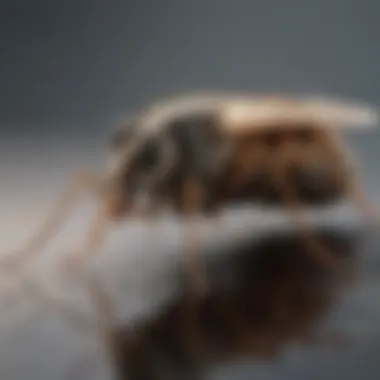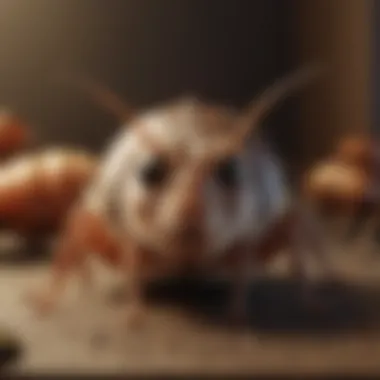Flock Free: Your Guide to a Pest-Free Home


Intro
Creating a home free from pests is not just about comfort; it’s about health and peace of mind. The presence of pests can lead to various health risks and significant discomfort. Understanding how to create a ‘flock free’ environment plays a critical role for homeowners and renters alike. The following sections will delve into the identification of common pests, prevention techniques, and eco-friendly pest control options, each aimed at providing you with a comprehensive approach to pest management.
Identification of Common Pests
Description of Common Pests
To effectively manage pests, it’s essential to recognize the most common culprits that may invade your living space. Common household pests include:
- Ants: Small but persistent, ants often invade kitchens and pantries.
- Cockroaches: Resilient and unhygienic, cockroaches tend to hide in dark areas and can contaminate food.
- Termites: Known for their destructive habits, termites feed on wood and can cause significant structural damage.
- Rodents: Mice and rats are not only nuisances but also health hazards as they can carry diseases.
- Bed Bugs: These pests can disrupt sleep and are notoriously difficult to eliminate.
Signs of Infestation
Identifying a pest problem early can prevent further issues. Common signs include:
- Droppings: Finding droppings is one of the first indicators of a pest presence.
- Gnaw Marks: Rodents often leave behind marks where they’ve chewed through materials.
- Nests: Visible nests may indicate a larger infestation nearby.
- Sounds: Scratching or scurrying noises, particularly at night, indicate rodent activity.
- Bite Marks or Rashes: Bites on your skin may suggest a bed bug infestation.
"The earlier you identify a pest problem, the easier it is to manage."
Prevention Techniques
Home Maintenance Tips
Preventing pests from entering your home is the first line of defense. Here are key steps to consider:
- Seal Cracks and Gaps: Regularly inspect your home for cracks and gaps that may allow pests to enter.
- Store Food Properly: Keep food in airtight containers to prevent attracting pests.
- Clean Regularly: A clean home is less appealing to pests. Focus on kitchens and dining areas.
- Proper Waste Management: Dispose of waste in sealed bins and take out garbage regularly.
Environmental Modifications
Small changes in your environment can greatly diminish the likelihood of pests:
- Remove Standing Water: Check for and eliminate sources of stagnant water, as these may attract mosquitoes.
- Maintain Your Yard: Keep shrubs and trees trimmed and remove debris that can shelter pests.
- Use Mulch Wisely: If using mulch, consider options that are less appealing to pests, like rock or rubber.
Eco-Friendly Pest Control Options
Natural Pesticides
Natural pesticides can be effective and less harmful to the environment. These include:
- Diatomaceous Earth: A non-toxic powder that can kill insects by dehydrating them.
- Neem Oil: Derived from the neem tree, this oil disrupts the lifecycle of insects and pests.
- Essential Oils: Certain essential oils, like lavender and peppermint, can repel pests naturally.
Organic Pest Control Techniques
Adopting organic methods offers a sustainable alternative to chemical pesticides. Some techniques to explore:
- Hand-Picking Pests: For small infestations, manually removing pests can be effective.
- Companion Planting: Some plants can repel pests naturally when planted near vulnerable crops.
- Traps: Simple traps can help capture and remove pests without lethal chemicals.
By understanding common pests, employing preventive measures, and utilizing eco-friendly options, homeowners can achieve a truly ‘flock free’ living environment. This ensures a healthier, more comfortable home for families.
Prolusion to Flock Free Living
Understanding the concept of a Flock Free environment is crucial for maintaining a healthy living space. This section will lay the groundwork for recognizing the significance of having a pest-free home. It will also articulate strategies homeowners can implement to achieve this goal.
Defining Flock Free
When we talk about feeling flock free, we refer to a space that is devoid of common pests such as ants, rodents, and insects. These unwanted guests not only disturb our peace but also threaten our comfort and safety. A flock free home means an environment that supports our well-being. Pest control is not merely about extermination but creating a long-lasting ecosystem where pests cannot thrive.
Importance of Pest Control
Pest control is an integral part of maintaining a healthy home. Common pests can pose significant risks to both physical health and property. For instance, rodents can contaminate food sources, while insects like termites can compromise the structural integrity of a house. Therefore, effective pest management is not something one should underestimate.
Good pest control methods can offer the following benefits:
- Health Protection: Minimizing the risk of diseases carried by pests.
- Financial Savings: Preventive measures can save costs associated with extermination and repairs.
- Comfort and Quality of Life: A pest-free home promotes better living conditions.
Maintaining pest-free living contributes to both personal well-being and overall community health.
Common Household Pests
Common household pests can disrupt the comfort and health of a home. They are not just unwelcome visitors; their presence may indicate deeper issues that need addressing. Understanding these pests is essential for effective pest management. This section discusses various types of common pests, their identification, and the signs of infestation.
Identifying Common Pests


Knowing how to identify common pests is the first step toward maintaining a pest-free environment. Different species display unique characteristics, behaviors, and risks to human health or property.
Types of Ants
There are many species of ants, each with specific behaviors and characteristics. For instance, carpenter ants are notable for their ability to tunnel through wood, making them a significant concern for homeowners. Their presence not only poses a risk of structural damage but also indicates potential moisture problems in the home. Sugar ants are drawn to food sources, easily invading kitchens and pantries. Their numbers can quickly grow, leading to more significant problems if not controlled. Ants tend to have a social structure that allows them to build colonies, with some species adapting to various environments. Understanding the types of ants helps homeowners take proactive measures against infestations, allowing for tailored pest management strategy.
Rodents
Rodents, such as mice and rats, are among the most common household pests. They are highly adaptable and can thrive in various environments. A primary characteristic of rodents is their ability to reproduce rapidly, leading to large populations in a short time. Rodents often cause damage to property, particularly through gnawing on wires, insulation, and other building materials, potentially creating fire hazards. Moreover, rodents can carry diseases harmful to humans and pets, underlining the necessity of prompt identification and management. It's critical to seal entry points to prevent rodent access into a home and to set traps if they are found.
Bed Bugs
Bed bugs are small, elusive insects that feed on human blood. They are particularly infamous because they can cause itchy bites, leading to discomfort and sleep disturbances. Their key characteristic is their ability to hide in small crevices and seams, making them challenging to detect until an infestation has taken hold. Bed bugs do not transmit diseases, but their presence often causes psychological stress for occupants. Recognizing bed bugs early is vital for effective treatment, and prevention methods should include regular inspections and avoiding bringing used furniture into the home without thorough checks.
Termites
Termites are wood-eating insects that can wreak havoc on structures if left unchecked. They work invisibly, often causing damage before detection. The key feature of termites is their ability to consume cellulose, which is found in wood and paper. This leads to significant structural risks in buildings. Regular inspections by professionals can help detect termite activity before severe damage occurs. Homeowners should also focus on minimizing moisture around the home and ensuring proper drainage to deter termite settlements. Identifying the signs early, coupled with preventative actions, can save significant costs in repairs later on.
Recognizing Signs of Infestation
Being able to recognize signs of infestation is crucial for early intervention. Promptly addressing potential pest issues can prevent them from growing into larger problems.
Visual Indicators
Visual indicators can include droppings, nesting materials, or even the pests themselves. Mouse droppings, for example, are small and dark, typically found in concentrated areas. Ant trails may lead to food sources, and seeing these trails is often the first indicator of an ant infestation. For bed bugs, physical appearance may alert homeowners; the small, brownish bugs may be visible on bedding or nearby surfaces. Recognizing these signs allows for quick action.
Odors
Certain pests produce musty or foul odors when they are present in large numbers. For instance, a strong, unpleasant smell may signal a rat problem. Similarly, the presence of dead pests may also create distinctive odors. These smells often indicate that an infestation has progressed significantly, requiring immediate attention to mitigate further issues.
Damage to Property
Damage to property, such as chewed wires, holes in walls, or wood structures weakened by termites, is a telltale sign of pest infestation. Not addressing these signs in time can lead to costly repairs and significant safety hazards. Understanding these indicators can empower homeowners to act quickly and minimize further risk.
"A stitch in time saves nine," applies well to pest-control practices. Early detection significantly reduces costs and hassle later.
Preventive Measures
Preventive measures are essential in achieving a pest-free living environment. Implementing these strategies not only helps in keeping unwanted creatures at bay but also promotes a healthier and more comfortable home. Being proactive rather than reactive in pest control can save time and significant costs associated with infestations.
Creating Pest-Resistant Environments
Creating pest-resistant environments involves making deliberate changes to your home that deter pests from entering and thriving. This approach significantly reduces the likelihood of infestations.
Sealing Entry Points
Sealing entry points is a fundamental aspect of creating pest-resistant environments. Pests often enter homes through small cracks and openings. Identifying and sealing these areas can drastically minimize pest access.
One key characteristic of sealing entry points is its cost-effectiveness. It requires minimal investment compared to how much one might spend on combating a full-blown infestation. Often, simple materials like caulk or weather stripping can effectively close gaps around doors, windows, and foundations.
The unique feature of this method is its proactive nature. By addressing potential entryways, you create a first line of defense. However, some might find it time-consuming to regularly inspect and seal potential gaps. A thorough inspection is necessary at least twice a year to maintain effectiveness.
Proper Food Storage
Proper food storage is vital in preventing pest attraction. Leaving food out in the open creates an inviting environment for pests such as ants, cockroaches, and rodents. Storing food in airtight containers is a simple yet crucial strategy.
The key characteristic of proper food storage is immediate attraction reduction. When food is sealed and stored away, it significantly decreases easy access for pests. This strategy is popular as it blends seamlessly into daily routines.
A unique feature of this approach is its dual benefit of maintaining food quality while preventing pest problems. However, some people may forget to store small items like snacks or pet food, which can compromise overall efforts. Being consistent in this habit is essential for long-term success.
Regular Cleaning
Regular cleaning is another essential preventive measure against pests. It eliminates food sources, nesting materials, and habitats that pests thrive on. Keeping spaces tidy and clutter-free can significantly lower infestation risks.
The key characteristic of regular cleaning is the immediate visibility it brings to pest problems. Spotting droppings or nests during cleaning can alert homeowners to potential infestations before they escalate.
What makes this method unique is that it fosters a overall culture of cleanliness. While some might find the task laborious, assigning specific chores or establishing a cleaning schedule can make it more manageable. On the downside, neglecting regular cleaning opens the door to easy infestations. It's a practice that requires daily commitment to be effective.
Landscaping and Outdoor Prevention
Landscaping and outdoor prevention involve strategies focused on the external environment to discourage pests from approaching your home. This can significantly augment indoor prevention efforts by addressing pest habitats:
Choosing Pest-Resistant Plants


Choosing pest-resistant plants is an effective way to beautify your landscape while reducing the likelihood of attracting pests. Some plants naturally repel insects or resist harm from them.
A key characteristic of pest-resistant plants is their natural defenses. For instance, marigolds can deter nematodes, while lavender can repel moths and mosquitoes. This eco-friendly choice not only supports a pest-free garden but also contributes to local biodiversity.
The unique feature here is that it requires no chemical intervention. However, one must select appropriate plants based on the local environment. Neglecting to research the suitability of certain plants can lead to poor outcomes.
Maintaining Outdoor Spaces
Maintaining outdoor spaces plays a crucial role in pest control. Overgrown grass, excessive leaf litter, or unmanaged gardens can create inviting habitats for various pests.
The key characteristic of maintaining outdoor spaces is promoting an overall health of the environment. Regular pruning of bushes and keeping grass trimmed reduces hiding spots for pests. It also enhances the aesthetics of your property.
A unique feature of this practice is its routine nature. Setting aside time for weekly maintenance instills good habits. However, some may consider it laborious, especially during warmer months. Neglecting these tasks can result in an increased pest population.
Integrated Pest Management (IPM)
Integrated Pest Management, or IPM, is a holistic approach to managing pests using a combination of techniques. It focuses on preventing pests while reducing the need for pesticides.
The key characteristic of IPM is its comprehensive nature. It integrates biological, cultural, and physical controls tailored to specific pest issues. This method addresses root causes of infestations rather than just treating symptoms.
A unique feature of this strategy is that it promotes ecological balance. It encourages understanding the lifecycle of pests and preventive measures specific to each. While beneficial, it may involve a learning curve for those unfamiliar with its principles. Proper education and community resources are critical in implementing IPM effectively.
Eco-Friendly Pest Control Options
The shift towards eco-friendly pest control options aligns with a deeper commitment to sustainability and health. In the context of pest management, these strategies emphasize the use of natural ingredients and methods that limit environmental impact. Eco-friendly choices are not just about reducing harm to the ecosystem; they also address safety concerns for family members and pets. Moreover, the effectiveness of these methods can often rival conventional practices, making them a compelling alternative for homeowners.
Natural Remedies
Essential Oils
Essential oils like peppermint and tea tree oil have gained significance in pest control. Their potent properties act as natural deterrents for several pests, including ants and spiders. This aspect is crucial as it emphasizes the shift from synthetic chemicals to more natural solutions in households. The key characteristic of essential oils is their ability to repel pests effectively without leaving harmful residues. However, one unique feature is the prolonged effect when used consistently. The advantages include safety, pleasant scents, and low cost. Yet, there are disadvantages to consider, such as potential allergic reactions in some individuals.
Homemade Traps
Homemade traps can be an incredibly efficient way to manage pest populations in your home. They utilize common household items like sugar and vinegar to attract and capture unwanted insects. The key characteristic of these traps is their accessibility and affordability. They are a beneficial choice because they require minimal investment and can be easily adapted to target specific pests. One unique feature is the ability to use materials that are already on hand. The advantages are numerous, including eco-friendliness and ease of use, but they might require frequent monitoring and maintenance as well.
Natural Repellents
Natural repellents serve as crucial tools in maintaining a pest-free environment. They can include items like garlic and diatomaceous earth. Their key characteristic is the ability to deter pests effectively while avoiding toxic substances. This makes them a popular choice for those looking to create a safer living space. The unique feature lies in how they can often be sourced locally and can be less expensive than commercial options. The advantages of natural repellents include reduced toxicity, but they might require more frequent application compared to chemical options, which can be seen as a disadvantage.
Chemical Alternatives
Organic Insecticides
Organic insecticides, such as those made from natural sources like neem oil, represent a significant development in pest management. They contribute to an eco-friendly approach while still providing effective pest control. The key characteristic of organic insecticides is that they tend to break down more quickly in the environment. This makes them a beneficial choice for those keen on minimizing chemical use. They can effectively target pests while being safer for humans and pets. However, one unique feature is that they may require more applications over time to remain effective. The advantages are evident in reduced environmental impacts, but potential disadvantages could include variable effectiveness depending on the pest and situation.
Microbial Pest Control
Microbial pest control utilizes living organisms to manage pest populations. This method can include beneficial bacteria or fungi to control harmful insects. Its key characteristic is the targeted approach to pest management, which minimizes collateral damage to beneficial species. It is a beneficial choice because it leverages nature's own systems for pest regulation. One unique feature is the ability to create a long-term balance rather than just a one-time solution. The advantages of this method involve ecological safety and reduced pesticide resistance, while the disadvantages might include the required specific conditions for effectiveness.
Botanical Solutions
Botanical solutions use plant-derived substances to control insects and pests. These solutions can include pyrethrum and citronella, which are effective against various pests. Their key characteristic is the natural origin, making them appealing to eco-conscious consumers. They serve as a popular choice for pest control among those looking for effective yet natural remedies. Their unique feature lies in the variety available, with different plants offering different modes of action against pests. The advantages include a safer alternative to synthetic pesticides, while the disadvantages might involve higher costs and sometimes complex application instructions.
Choosing eco-friendly pest control options is not just a trend; it reflects a fundamental shift towards sustainable living and safety for all household members.
Professional Pest Control Services
Professional pest control services play a crucial role in the management of common household pests. These services are designed to address infestations effectively and efficiently. They utilize trained experts who understand pest behavior, ecology, and the best practices for controlling specific species. This knowledge allows pest control professionals to devise tailored strategies that fit the unique needs of each home.
Hiring a professional service often results in long-term solutions rather than temporary fixes. Through a combination of prevention, monitoring, and treatment, these companies help maintain a flock free environment. Homeowners can expect several benefits from professional services, such as use of specialized equipment and access to advanced pest control methods in addition to expert advice on preventing future infestations.
When to Call a Professional
Severe Infestations
Severe infestations can overwhelm homeowners, making it difficult for them to manage pests independently. This aspect contributes significantly to the overall pest control discussion, as severe cases often require specialized intervention. A key characteristic of severe infestations is their rapid growth; numbers can escalate quickly, leading to extensive damage and increased health risks. When the infestation affects multiple areas of a home, professional aid becomes not just helpful, but essential.
The unique feature of handling severe infestations lies in the comprehensive approaches utilized by pest control experts. For instance, they may employ integrated pest management strategies that focus on both elimination and prevention, which can prove beneficial in the long run. However, it's crucial to remember that each situation can present disadvantages, such as increased costs or the need for temporary displacement during treatment.
Health Risks


Health risks associated with pests can make calling professionals a priority for homeowners. Pests like rodents and cockroaches can carry diseases, contaminating food and spreading pathogens. Recognizing health risks is vital as it relates directly to personal wellbeing and family safety. A key characteristic of addressing health risks is its proactive nature; hiring a pest control service aids in mitigating potential hazards before they escalate into significant threats.
The unique feature here is that professional pest control can provide more than eradication; they often offer long-term solutions to avoid health-related issues. Nonetheless, the disadvantages may include exposure to chemicals and treatments that could affect family members, especially those with allergies or sensitivities.
Complex Scenarios
Complex pest scenarios often arise in multifaceted environments. These situations may involve multiple pest species or unique structural challenges that prevent standard remedies from working effectively. The complexity of such scenarios often requires advanced knowledge and techniques, thus making professional intervention a strategic choice. A key characteristic of these scenarios is their unpredictable nature; pests may not respond as expected, demanding ongoing adjustments to treatment plans.
Professionals possess the skills to analyze and adapt strategies for these complex cases. The unique feature of addressing complex scenarios is that it can lead to innovative solutions that are specifically tailored to a home's unique conditions. However, this may also mean longer treatment durations or higher costs, which should be considered by homeowners.
Choosing a Pest Control Company
Selecting the right pest control company is essential to ensure a successful resolution to pest issues. Homeowners should be aware of several critical factors that can influence their choice, including licensing, customer reviews, and service options.
Licensing and Certifications
Licensing and certifications emphasize the reliability of a pest control company. These credentials prove that the company adheres to regional regulations and industry standards. Ensuring the company is licensed offers peace of mind, knowing that pest control professionals received adequate training to handle pest issues safely and effectively. The unique benefit of choosing licensed services is access to the latest methods and products that are legally permitted.
Customer Reviews
Customer reviews serve as a powerful tool for assessing the quality of a pest control company. Reviews often reflect the real experiences of past clients, which can help potential customers gauge effectiveness and customer satisfaction. This aspect is beneficial because it provides insight into the company's reputation and performance. The unique feature of relying on customer feedback is that it can identify strengths and weaknesses within the company, assisting homeowners in making informed decisions.
Service Options
Service options offered by pest control companies can vary significantly. Understanding these options enables homeowners to choose services that best suit their individual needs. Factors affecting service options include frequency of treatments, types of pests targeted, and customized solutions for specific infestations. It is beneficial for homeowners to inquire about different service tiers and their coverage to ensure they select a fitting plan. However, the unique downside might be that fewer options may not provide sufficient coverage if homeowners are dealing with varied pest concerns.
Maintaining a Flock Free Home
Maintaining a flock free home is essential to uphold a healthy living environment. A proactive approach not only aids in preventing infestations but also protects property values and enhances overall comfort. Residents should recognize that the absence of pests contributes significantly to peace of mind. Homeowners often overlook regular maintenance, which can lead to unforeseen issues that might become costly in the long run.
Regular Maintenance Practices
Routine Inspections
Routine inspections are a critical practice for optimizing pest control. By routinely examining the home, residents can identify vulnerabilities that may attract pests. This proactive strategy allows for early detection of potential problems, making it much easier to address issues before they escalate. One strong characteristic of routine inspections is their frequency. Many experts recommend conducting these at least once a season. This is beneficial for catching pests in their early stages. The unique feature of routine inspections is their comprehensive nature, which covers all areas of the home.
Their disadvantages include the time commitment required. However, the long-term savings can outweigh this effort. Regular inspections can ultimately prevent more serious infestations and damage to the home.
Seasonal Strategies
Seasonal strategies play an important role in maintaining a pest-free home. Each season presents unique pest challenges. For instance, spring and summer are prime times for insects, while winter can see rodents seeking shelter indoors. The key characteristic of seasonal strategies is their adaptability to changing conditions. This ensures that homeowners are prepared for potential pests at any time of year.
The uniqueness of this approach lies in its ability to use natural cycles to target specific pest behaviors. However, a downside is that these strategies may require ongoing adjustments based on current conditions. The effort involved can make this a bit complex, yet the preventive measures provided are invaluable.
Community Strategies
Community strategies have a significant impact on maintaining a flock free environment. Engaging with local organizations can enhance knowledge and resources available. One of the critical aspects is the collaboration among neighbors, which can lead to shared insights on pest issues. This contributes greatly to strengthening community-wide pest prevention.
The unique feature is the ability to leverage community resources, such as workshops and shared pest control services. However, it can require a commitment of time and participation by community members. Still, fostering relationships within the neighborhood can provide broader benefits that extend beyond individual homes.
Education and Awareness
Education and awareness are vital to maintain a pest-free home. Understanding pest behaviors, staying informed on new trends, and engaging with community resources enhance resident capability in pest management. These elements create a comprehensive knowledge base that empowers residents.
Understanding Pest Behaviors
Understanding pest behaviors provides insights into preventing infestations. Each pest has specific patterns and habits that can be anticipated. The key characteristic here is knowledge; the more a homeowner knows about pests, the better prepared they are to manage them. This kind of understanding is beneficial because it enables targeted prevention strategies. The uniqueness of this approach is that it fosters a proactive rather than reactive mindset, aiding in the overall goal of a flock free home. One disadvantage is that not all homeowners may dedicate time to such learning, which could limit effectiveness.
Staying Informed on New Trends
Staying informed on new trends ensures that residents utilize the latest methods in pest prevention. Continuous research has led to innovative solutions that can be more effective and eco-friendly. A key characteristic of this approach is its dynamic nature; as trends shift, so too can strategies for pest control. This is beneficial as it often leads to significant improvements in pest management effectiveness. The uniqueness lies in the availability of various mediums to stay informed, such as online forums, articles, and pest control professional insights. A disadvantage might be the overwhelming amount of information, which can sometimes confuse rather than clarify the situation.
Engaging with Community Resources
Engaging with community resources is a way to enhance pest management knowledge and apply those insights on a broader scale. This creates opportunities for residents to connect and learn from one another. The key characteristic is the collective effort in sharing experiences and strategies. This is beneficial as it often leads to a unified approach to pest control within a community. The uniqueness here is the blend of personal experience and shared knowledge, allowing for tailored solutions that are specifically relevant to local pest problems. However, some community members may feel hesitant to engage due to lack of time or interest, which can limit effectiveness.
By focusing on regular practices, education, and community engagement, homeowners can foster an environment that is not just pest-free but also contributes to overall living quality.
The End
Achieving a pest-free home is not just a matter of comfort; it is crucial for health and well-being. The concept of a flock free living emphasizes the need to take proactive measures in pest management. This article has outlined essential strategies ranging from identification of common pests to eco-friendly control methods. Understanding the dynamics of pest behavior and focusing on preventive actions can significantly diminish the likelihood of infestations.
Summarizing Flock Free Objectives
The main objectives of maintaining a flock free environment are clear. First, it is about safeguarding your living space from common pests like ants, rodents, and termites that can cause health risks or property damage. Second, employing preventative measures such as proper food storage and sealing entry points contributes to risk reduction. Third, embracing eco-friendly pest control alternatives ensures not only the elimination of pests but also promotes a safer environment for humans and pets alike. Each of these aspects converges to create a home that prioritizes health and comfort.
Future of Pest Control
As technology advances, the future of pest control is steering towards more innovative solutions. Integrated Pest Management (IPM) is becoming more popular, combining effective pest control techniques for improved outcomes. The use of data analytics to predict pest behavior can also become more sophisticated. This evolution opens up opportunities for greater efficiency in pest control processes and a shift towards sustainable methods. Homeowners should remain informed about new trends and explore the possibilities that these advancements in pest control offer. Staying proactive and adaptable can lead to a truly flock free home.







